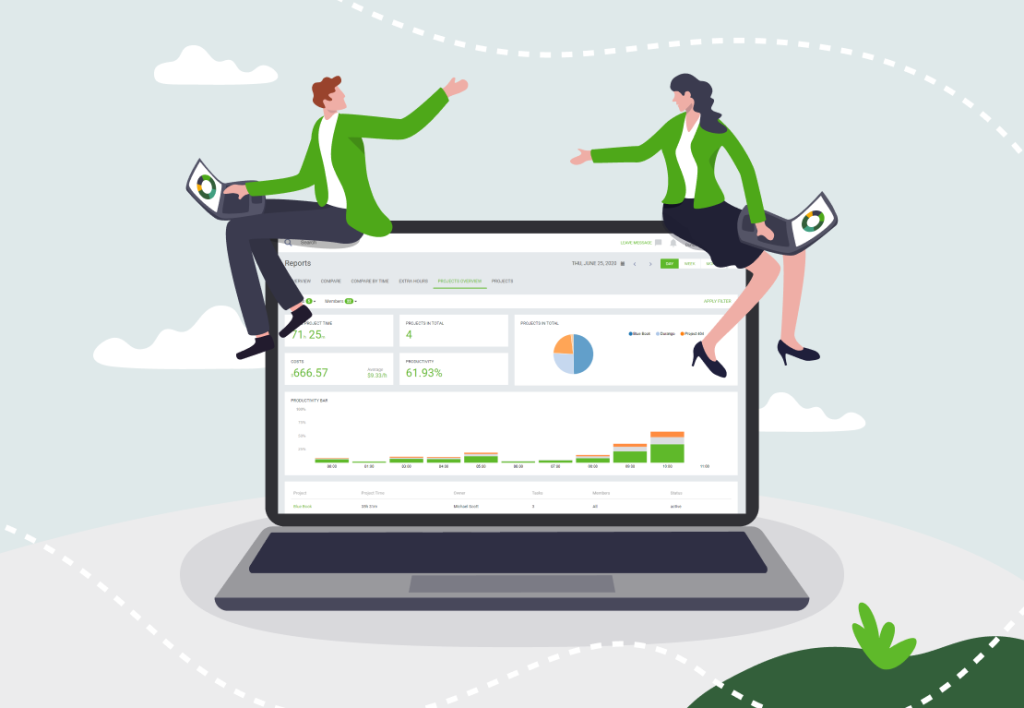Survey reveals employees are fine with monitoring – as long as they can see the data

Employee monitoring has been a touchy subject over recent years. As people switched to working from home during the pandemic, companies and managers sought ways to keep an eye on remote worker productivity and attendance. This led to a massive boost in the adoption of employee monitoring software.
The general consensus is that people don’t like to be monitored at work. It can feel like an intrusion on personal space and like management doesn’t trust you to complete your work on your own. At least, that was the assumption. But you know what they say about assuming…
Want to get the most out of your time?
Try DeskTime for free!
Try free for 14 days · No credit card required.
By signing up, you agree to our terms and privacy policy.

A recent study by data science company Profusion revealed that 61% of employees are comfortable with monitoring technology and data being used to monitor their output, activity, or presence.
It’s about the manager, not the technology
The issue isn’t the monitoring itself, but rather how it’s done – 81% of respondents said that data must be made available to employees to enable them to challenge any interpretations. In other words, as long as the technology is used transparently and collaboratively, the majority of employees are fine with monitoring.
But the reality is that this is rarely how monitoring happens. The same survey indicated that one in four employees are unaware of whether the data was used for performance reviews. Only 26% were provided with a copy of data in advance of reviews and, worse yet, only 25% said they are empowered to challenge the interpretation. This is particularly scary when you consider that 9 out 10 employers have fired an employee based on monitoring software data.
The takeaway from this is that when employees complain about monitoring tools, they’re not complaining about the technology itself, but rather about the managers that (mis)use it.
Companies often have the wrong mindset in regard to monitoring. It’s typical to think of these apps as one-sided surveillance mechanisms, and when they’re used as such, employees are more likely to be dissatisfied with monitoring. This can lead to people pushing back and even quitting.
But it doesn’t have to be this way. Employees can also greatly benefit from time-tracking for a variety of reasons and the sooner organizations understand this, the sooner they’ll be able to find common ground with employees as far as monitoring is concerned.
The benefits of monitoring for employees
How much an employee will benefit from monitoring tools depends on what specific tool you use. For example, with DeskTime, employees can track their own attendance, productivity levels, and performance, among other things. As a result, workers can benefit in the following ways.
Work-life balance
Working remotely can quickly break down work-life boundaries. Checking emails after work or doing a quick task in the evening – these are common things that negatively affect worker well-being and increase the likelihood of burnout. Time-tracking apps allow employees to keep track of their daily hours to avoid overworking.
Personal improvement
DeskTime tracks where time is spent and how productively. By seeing this data, employees can evaluate their own performance and habits. In turn, they can optimize their working day by, for example, focusing on deep work during periods when they’re most productive or identifying bad working habits and taking proactive measures to improve their performance.
Data-based performance reviews
Having access to their own productivity data enables employees to more objectively participate in performance reviews or discussion with HR. They can directly point to how they’ve been doing, show how they spend their time, and defend themselves against unfair accusations.
How to get employee monitoring right as a manager
Secrecy about monitoring is not the way forward – it’ll only foster fear, resentment, and distrust. Instead, complete transparency should be practiced. If you do the following three things, your team is more likely to embrace monitoring tools.
1. Discuss the various features/functionalities so everyone’s informed
To avoid a big brother feeling, it’s a good idea to explain what your monitoring software of choice is and highlight its time tracking features. Going over the functionalities will ensure that employees know how it works and that they don’t have to worry about any non-consensual spying.
2. Explain how and why the monitoring tool will be used
Be transparent about why you’re introducing the tool. Monitoring employees is a very good reason on its own, so don’t try to sugarcoat it too much. Explain how exactly it will be used – for daily supervision, performance reviews, or otherwise.
3. Train your employees to take full advantage of the software
Most importantly, make sure your employees know how they will benefit from the software. It will empower them to improve their performance, work-life balance, and negotiating position. For them to take advantage of the monitoring tool, consider running some courses on how to use it to its full potential.

Want to keep your team happy?
Time tracking is a great tool to avoid employee burnout.
Parting remarks
Monitoring software is likely to become a mainstay of the modern working environment. It offers so many benefits to both managers and employees that it no longer makes sense to avoid it.
But to avoid a one-sided relationship where employees think you’re spying on them, the implementation must happen transparently and collaboratively. Otherwise, you risk losing valuable employees that might not be OK with surveillance. But, as the study reveals, it’s not the monitoring itself that workers don’t like, but rather opaque surveillance.
So take heed of our suggestions and work together with your teams to usher in a new way of working that will benefit everyone involved. And if you’re in the market for a time-tracking app, play around with DeskTime’s demo to see if it’s right for your organization.
Did you find this article useful? Give it a clap!
Psst! You can clap more than once if you really loved it 🙂